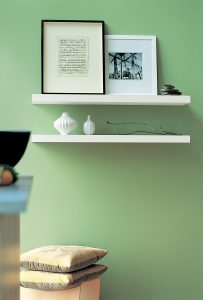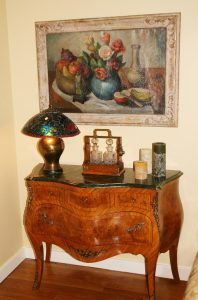By THERESA PEASE
Ok, so you’ve closed on your perfect Cape Cod abode—a rambling saltbox with windows facing the sea, or a contemporary townhome with walls of glass overlooking a marsh or cranberry bog. Maybe you’ve renovated your great aunt’s cottage, downsized to a snug condo, or annexed a wing to accommodate your growing family. The location is right, the size is perfect, your new window treatments are hung, and you’ve updated to the chic modern furniture you’ve always wanted.
 If things still don’t feel quite right, it might be time to have a closer look at your walls.
If things still don’t feel quite right, it might be time to have a closer look at your walls.
If they stare back at you with pristine blankness, your home may simply be in search of its soul. An unadorned expanse of paint or shiplap tells nothing about who lives here. What is important to you? Where have you been, and where are you going? Do you have classical aspirations or a cutting-edge vibe? Is your attitude playful, reverential or nature-loving?
Even if your walls are dense with memorabilia, take a critical second glance. Doubtless you long ago ditched the velvet Elvis that Grampa once hung over his knotty pine bar, but even so, your collection may not suit your current space. Worse, it may ill define what it is that lights your fire in 2018. The soft, hand-tinted Wallace Nutting photos or meticulously detailed etchings that thrilled you in your honeymoon bungalow may be lost on a wall the size of the Green Monster. The posters you picked up for your college dorm may be strangely out of place in your grown-up world. Even your thrifty lithographic prints of works by Van Gogh, da Vinci, or Warhol may undermine your personal aesthetic.
Getting Started
Fortunately, help is at hand. The Falmouth area, like most seaside communities, is well-populated with artists, gallery owners, framers, and designers willing to invest time and energy in helping you create the environment of your personal dreams.
In an ideal world, you might walk into a gallery, browse for 20 minutes and be struck by a masterpiece that makes your heart sing—one that completes your vision, expresses your enthusiasms and gets your dwelling ready for a magazine photo shoot. And sometimes it really happens that way.
“Art appreciation is very subjective, and there doesn’t have to be any logic in it. You know it when you see it,” said Doug Rugh, co-owner of Osborn & Rugh Gallery in Falmouth. Agreed partner Hillary Osborn, “People are going to get work that is right for them, something that empowers or uplifts them, and it’s not unusual for clients to buy purely for the gut reaction, the emotional response that they have to a painting.”
 But with so many choices, and so many variables to consider, don’t be surprised if your gut leaves you awash with ambivalence. That’s when you should sit down with and unburden yourself to a pro. Osborn & Rugh calls it the Interview; owner-artist Karen Rinaldo of the Gallery on Main at 317 Main Street in Falmouth refers to it as the Conversation; and framer John Miller of Deer Crossing in Mashpee describes it as the Q&A.
But with so many choices, and so many variables to consider, don’t be surprised if your gut leaves you awash with ambivalence. That’s when you should sit down with and unburden yourself to a pro. Osborn & Rugh calls it the Interview; owner-artist Karen Rinaldo of the Gallery on Main at 317 Main Street in Falmouth refers to it as the Conversation; and framer John Miller of Deer Crossing in Mashpee describes it as the Q&A.
After allowing you to browse uninterrupted for a while, your art adviser will talk to you about your available space, your color preferences, your general style, and, perhaps most important, how you want your home to feel.
At Osborn & Rugh, the proprietors—a husband-wife team of oil painters whose talents run the gamut from formal and classical to more contemporary renderings—will show you a variety of styles to hone in on what it is you want to see every day of your life. Do you find yourself drawn to specific subjects—say, lighthouses or sailboats? Do you gravitate toward rich colors, or a soft and gentle palette? Are you calmed by still life paintings, nostalgic about shadowy interiors, or stimulated by a fiery sunrise as you awaken? What about portraits? Does your space favor giant compositions in jazzy hues, or are you hoping to bedeck your nooks and crannies with quiet groupings of smaller works?
If you’re still insecure about your leanings, Osborn & Rugh will even drive a painting to your home, hang it, and let you live with it for a few days before committing to the purchase.
When a client lives far afield of Falmouth, Ms. Osborn said, she sometimes asks them to e-mail her photos of their interior, into which she can embed digital images of recommended paintings and send them back in a couple of hours.
“The main thing is that you want your client to be happy. You want it to be a good fit,” Ms. Osborn said.
But suppose you’ve done all that and you still haven’t found the work that speaks to your spirit? That, Osborn & Rugh agreed, is where the commissioned work comes in.
“Because,” as Mr. Rugh quipped, “we are really a studio pretending to be a gallery,” the twosome is at its happiest when working collaboratively with clients to materialize their personal visions. If you want to capture a view of the cove outside your window, immortalize a loved one, or capture the spirit of your home or pet, they will make it happen. Sometimes, they will even do a custom version of something that’s already on their walls.
Ms. Osborn told of a client who found an appealing picture of the backwater at Menauhant Beach, where her children swim—but wanted it larger, to fill the space above her mantle, and fast forwarded into its summer colors, rather than the fall tones shown in the original. Another, she recalled, wanted a still life featuring food items she loved. The artist created a few possible set-ups and e-mailed photos of them to her, and the two sent images back and forth like ping-pong balls until they had co-created the idea piece for the collector’s kitchen. But suppose you can’t be satisfied with anything less dramatic than John Singer Sargent’s painting of Mrs. X? No worries, Ms. Osborne said. For time-honored works in the public domain, her husband can whip up a convincing (and legal) copy.
Putting A Price On Art
 At Osborn & Rugh, entry-level paintings of the smallest size are priced at $600, while a more expansive work can go for upward of $10,000—or even higher for a commissioned work in large scale. For those whose budget is on the low end, Ms. Osborn suggests approaching gallery owners to work out a payment plan that helps them afford a piece of original art.
At Osborn & Rugh, entry-level paintings of the smallest size are priced at $600, while a more expansive work can go for upward of $10,000—or even higher for a commissioned work in large scale. For those whose budget is on the low end, Ms. Osborn suggests approaching gallery owners to work out a payment plan that helps them afford a piece of original art.
“You can find any image you want online,” said Mr. Rugh, “but people still like to see hand-made oil paintings in person. It’s not the same unless you can see the brushstrokes, the surface of the paint, and its nuanced hues. A great painting in the home will reveal things for years to come.”
Ms. Osborn often reflects on how even the younger browsers have a way of responding to real art when they see it. One little girl happened upon a small painting of a horse and didn’t want to leave without it. Luckily for her, her mom purchased it for her, seizing on the opportunity to inspire a lifelong art lover.
At the Gallery on Main, the “real art” covers a wider span of mediums and prices. Karen Rinaldo, a popular painter of local Falmouth color and culture, teamed up with musician Donald Cross in December 2017 to open Falmouth’s newest artsvenue. The gallery showcases works in genres and styles that include realism, abstraction, photography, watercolors, oil paintings, collage and small sculptural pieces. Among the 26 notable exhibitors are Rinaldo herself as well as painters Jan Collins Selman, Julia O’Malley-Keyes, Ryan Young, and Jim Musto, along with photographers Michael Petrizzo, Kevin McCarthy and Kevin Doyle. Prices range from $25 to $3,500. “Sometimes,” she said, “people come through the door thinking everything is going to be out of their reach. But our prices are so fair that they find themselves walking out with three pieces for what they thought was their budget for one.”
Nevertheless, for those who crave a more substantial painting than a modest budget can support, she suggests considering the purchase of a giclée print.
A relatively recent innovation in the art world, giclée—which can be translated as sprayed ink—updates the art printing process the way ink-jet printers transformed text. Using archival ink on canvas, an original can be reproduced in such a way that it virtually replicates the original painting. Museums use giclée to create works for their gift shops, or to represent paintings not available for current exhibition. “Instead of spending thousands of dollars,” Ms. Rinaldo asserted, “people can take home a piece of their favorite artist for a couple of hundred dollars.”
Like Osborn & Rugh, Ms. Rinaldo goes the extra mile to help both experienced and fledgling buyers find a work that will deliver that personal sense of emotional connection. Art is “a great conversation-starter,” she said, and sometimes viewers are drawn to converse about works that do not exactly echo the styles of their homes. Someone in an ultra-modern environment, for example, may be smitten with a traditional landscape that somehow “speaks to them” or a still life in the spirit of the Old Masters. From Ms. Rinaldo’s viewpoint, there is no conflict there. “To me,” she said, “a great piece of art can fit into any décor, in any style home. You just have to make that heartfelt connection.” Like Osborn & Rugh, she also allows potential buyers to install a work in their house for a trial period before saying “I do.”
It’s A Frame-Up
 For those who discover a work they like in a frame that doesn’t work with their décor, doesn’t seem to suit the art itself, or simply doesn’t look pleasing to the buyer, the Gallery on Main showcases a limited selection framing options by John Miller. Just a few miles down Route 28, though, his shop, J Miller Pictureframer & Gallery, hosts a mind-boggling display of 35,000 frames to suit every taste.
For those who discover a work they like in a frame that doesn’t work with their décor, doesn’t seem to suit the art itself, or simply doesn’t look pleasing to the buyer, the Gallery on Main showcases a limited selection framing options by John Miller. Just a few miles down Route 28, though, his shop, J Miller Pictureframer & Gallery, hosts a mind-boggling display of 35,000 frames to suit every taste.
Mr. Miller, currently board of trustees president of Cahoon Museum of American Art in Cotuit, also sells paintings and prints by area artists working in a range of media. Nearly 20 years in the framing business, along with leadership roles in multiple cultural organizations, equips him to discuss art with anyone who enters his shop. His connections with area artists and galleries often assist him to help his customers find what they want. But his expertise, he admitted, is in the framing practice that accounts for 95 percent of his trade.
Some customers—individuals and businesses—bring Mr. Miller new items that need framing for the first time. Others seek new frames to unify their collections or to complement better the age and subject matter of the work. “In some cases, the frames that came on the art when they bought it are so inappropriate that it’s a huge distraction. It’s not flattering to either the artist or the painting,” he said.
In Mr. Miller’s field, there are sometimes surprises. One couple, he notes, came in with a nondescript work that seemed at war with its timeworn frame. When he removed the work to reframe it, he discovered that the drab painting had been superimposed over an older print.
“Underneath it was a Rembrandt etching,” he said. “I sent the couple to an appraiser I know and trust. They wound up putting the piece up for auction, and it sold for $37,000.”
Art Placing Tips From A Pro
Now that you’ve got it, what will you do with it? Gallery owners, artists and interior decorators are happy to help you locate and arrange your art, whether you’re hanging a single picture or a houseful of images.
 For do-it-yourselfers, artist Michelle Law, who hangs art for individual clients as well as for the spacious gallery at Cotuit Center for the Arts, delivers the happy news that there is no right or wrong way to choose, group, or display art. The whole point of artistic passion is that it is personally experienced and personally celebrated. Still, she has some helpful tips.
For do-it-yourselfers, artist Michelle Law, who hangs art for individual clients as well as for the spacious gallery at Cotuit Center for the Arts, delivers the happy news that there is no right or wrong way to choose, group, or display art. The whole point of artistic passion is that it is personally experienced and personally celebrated. Still, she has some helpful tips.
• Buy art that really moves you. Select a piece that makes your heart stop beating for a moment and invokes an emotion you want to live with for the rest of your life.
• Start with an anchor piece—perhaps a large painting over a sofa or a signature work above the mantel—then plan other placements in relationship to that.
• Pull together groups of items with a common element. Do they all offer ocean views? Have black frames? Share color tones? If you find a commonality, it helps pull smaller works together instead of having them hang there like so many refrigerator magnets.
• Don’t be afraid to edit your collection. “When I hang a whole house for people, I ask them first to identify the five things that they must have,” said Ms. Law, “after that, go to the ‘maybe’ pile and add what works for a clean, light look, then put the rest in storage.”
• Keep things in scale. If you group small objects on a huge wall in a great room, all you’ll see from across the room is frames or blobs. Place something there that reads from a distance.
• Be flexible. In the gallery, Ms. Law said she maintains the focal point at five feet from the floor for good visibility. “At home,” she advises, “there’s more flexibility. You need to keep the furniture in mind. You may want to double-hang—that is, position one painting above another—or make a random arrangement.”
• Plan it out first. “I lay works out on the floor and see how they look in relation to each other,” said Ms. Law, “then transfer the arrangement to the wall. It’s easiest to deal with odd numbers; pick three or five objects.”
• Create continuity by grouping works a set distance apart—say, three inches—both horizontally and vertically.
• Look not just at shape and size, but context. “Once in the gallery,” recalled Ms. Law, “we were so focused on composition that we almost didn’t notice we were about to hang a painting of angry ducks right beside a picture of an elderly man. It looked like they were about to attack him.”
• Don’t let a frame overwhelm the work. Let the art speak for itself. Ms. Law said that personally she does not like to use colorful frames, “but that’s just my personal preference.”
• Be aware of light sources. You want to see the art, but some mediums can be harmed by too much natural light.
• People often hang things too high, so you don’t enjoy the work and you can’t see the little details. You don’t want to hang a piece so low you’ll bump your head on it over the sofa, but you also don’t want it floating in the clouds.
• Keep everything level. “Keeping things level is crucial,” said Ms. Law. “I use a material called Poster Tack. You roll up a small ball, the size of a baby pea, to anchor the work in one corner, and it doesn’t go anywhere.”

